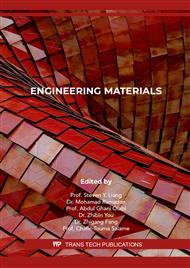[1]
Sathishkumar, T.P., Satheeshkumar, S. and Naveen, J. (2014). Glass fiber-reinforced polymer composites–a review. Journal of reinforced plastics and composites, 33(13), pp.1258-1275.
DOI: 10.1177/0731684414530790
Google Scholar
[2]
Mathew, M.T., Padaki, N.V., Rocha, L.A., Gomes, J.R. , Alagirusamy, R., Deopura, B.L. and Fangueiro, R., (2017). Tribological properties of the directionally oriented warp knit GFRP composites. Wear, 263 (7-12), pp.930-938, doi.org/10.1016/j.wear.2006.12.001.
DOI: 10.1016/j.wear.2006.12.001
Google Scholar
[3]
Pereira, G.F., Mikkelsen, L.P. and McGugan, M., (2015). Crack detection in fibre reinforced plastic structures using embedded fibre bragg grating sensors: Theory, model development and experimental validation. PloS one, 10(10), pp.e0141495.
DOI: 10.1371/journal.pone.0141495
Google Scholar
[4]
Khan, T., Bin Hameed Sultan, M.T. and Ariffin, A.H., (2018). The challenges of natural fiber in manufacturing, material selection, and technology application: A review. J. Reinf. Plast. Compos., vol. 37, no. 11, p.770–779,.
DOI: 10.1177/0731684418756762
Google Scholar
[5]
Prashanth, S., Subbaya, K.M., Nithin, K. and Sachhidananda, S., (2017). Fiber reinforced composites-a review. J. Mater. Sci. Eng, 6(03), pp.2-6.
Google Scholar
[6]
Hart-Smith, LJ., (1987). Engineered Materials Handbook (Vol. 1). ASM International, Ohio 479-495.
Google Scholar
[7]
Allred, RE., (2005). Carbon-reinforced composite recycling: process and business development. In Global Outlook for Carbon Fibers 2005, Intertech Conferences, San Diego, CA.
Google Scholar
[8]
Rajpurohit, A., Joannès, S., Singery, V., Sanial, P. and Laiarinandrasana , L., (2020). Hybrid Effect in In-Plane Loading of Carbon/Glass Fibre Based Inter- and Intraply Hybrid Composites. J. Compos. Sci., vol. 4, no. 1, p.6,.
DOI: 10.3390/jcs4010006
Google Scholar
[9]
Dong, C., (2020). Optimal design of carbon and glass reinforced hybrid composite pipes under flexural loading). Forces Mech., vol. 2, p.100003, 2021,.
DOI: 10.1016/j.finmec.2020.100003
Google Scholar
[10]
Mishnaevsky, L. and Dai, G., (2014). Hybrid carbon/glass fiber composites: Micromechanical analysis of structure-damage resistance relationships. Comput. Mater. Sci., vol. 81, p.630–640,.
DOI: 10.1016/j.commatsci.2013.08.024
Google Scholar
[11]
Forintos, N. and Czigany, T., (2020). Reinforcing carbon fibers as sensors: The effect of temperature and humidity. Compos. Part A Appl. Sci. Manuf., vol. 131, p.105819, doi: https://doi.org/10.1016/j.compositesa.2020.105819.
DOI: 10.1016/j.compositesa.2020.105819
Google Scholar
[12]
Alexopoulos, N.D., Bartholome, C., Poulin, P. and Marioli-Riga, Z., (2010). Structural health monitoring of glass fiber reinforced composites using embedded carbon nanotube (CNT) fibers. Composites Science and Technology, 70(2), pp.260-271.
DOI: 10.1016/j.compscitech.2009.10.017
Google Scholar
[13]
Shen, Z. and Zhou, H., (2017). Mechanical and electrical behavior of carbon fiber structural capacitors: Effects of delamination and interlaminar damage. Composite Structures, 166, pp.38-48.
DOI: 10.1016/j.compstruct.2016.12.062
Google Scholar
[14]
Hiremath CP, Senthilnathan K, Naik N, Guha A, Tewari A., (2018). Microstructural damage based modeling of thermal conductivity of cyclically loaded CFRP. Compos Sci Technol;154:37–44.
DOI: 10.1016/j.compscitech.2017.11.011
Google Scholar
[15]
McCrory JP., Al-Jumaili SK., Crivelli D., Pearson MR., Eaton MJ., Featherston CA., (2015). Damage classification in carbon fibre composites using acoustic emission: A comparison of three techniques. Composites B; 68:424–30.
DOI: 10.1016/j.compositesb.2014.08.046
Google Scholar
[16]
Shrestha P., Park Y., Kim C-G., (2017). Low velocity impact localization on composite wing structure using error outlier based algorithm and FBG sensors. Composites B 2017;116:298–312.
DOI: 10.1016/j.compositesb.2016.10.068
Google Scholar
[17]
Alsaadi, A., Meredith, J., Swait, T., Curiel-Sosa, J.L., Jia, Y. and Hayes, S., (2019). Structural health monitoring for woven fabric CFRP laminates. Composites Part B: Engineering, 174, p.107048.
DOI: 10.1016/j.compositesb.2019.107048
Google Scholar
[18]
Nassr, A.A. and El-Dakhakhni, W.W., (2011). Improved interdigital sensors for structural health monitoring of composite retrofit systems. Journal of reinforced plastics and composites, 30(7), pp.621-629.
DOI: 10.1177/0731684411399944
Google Scholar
[19]
Sause, MG., (2016). Combination of methods. In: In situ monitoring of fiber-reinforced composites. Springer, p.533–609.
DOI: 10.1007/978-3-319-30954-5_7
Google Scholar
[20]
ECC, F., (2005). Technical data sheet Technical data sheet, Engineered Cramer Composites Cell, http://www.ezentrumbilder.de/rg/pdf/td_en_ECC_Style452-5_E.pdf.
Google Scholar


